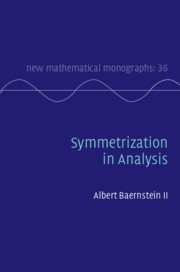Book contents
- Frontmatter
- Contents
- Notation
- Foreword
- Preface
- Introduction
- 1 Rearrangements
- 2 Main Inequalities on Rn3
- 3 Dirichlet Integral Inequalities
- 4 Geometric Isoperimetric and Sharp Sobolev Inequalities
- 5 Isoperimetric Inequalities for Physical Quantities
- 6 Steiner Symmetrization
- 7 Symmetrization on Spheres, and Hyperbolic and Gauss Spaces
- 8 Convolution and Beyond
- 9 The ⋆-Function
- 10 Comparison Principles for Semilinear Poisson PDEs
- 11 The ⋆-Function in Complex Analysis
- References
- Index
10 - Comparison Principles for Semilinear Poisson PDEs
Published online by Cambridge University Press: 22 February 2019
- Frontmatter
- Contents
- Notation
- Foreword
- Preface
- Introduction
- 1 Rearrangements
- 2 Main Inequalities on Rn3
- 3 Dirichlet Integral Inequalities
- 4 Geometric Isoperimetric and Sharp Sobolev Inequalities
- 5 Isoperimetric Inequalities for Physical Quantities
- 6 Steiner Symmetrization
- 7 Symmetrization on Spheres, and Hyperbolic and Gauss Spaces
- 8 Convolution and Beyond
- 9 The ⋆-Function
- 10 Comparison Principles for Semilinear Poisson PDEs
- 11 The ⋆-Function in Complex Analysis
- References
- Index
Summary
Chapter 10 establishes comparison principles for solutions of partial differential equations. The prototypical result says that the solution of Poisson's equation gets bigger in an integral sense when the data in the equation is rearranged. Such comparisons have been used in the literature for deriving sharp bounds on certain eigenvalues, obtaining a priori bounds on solutions, and comparing Green functions, among other uses. These integral norm comparisons follow from star function comparisons, and so the task is to prove that rearranging the data in Poisson's equation increases the star function of the solution. The key is a maximum principle argument applied to the difference of star functions, making use of subharmonicity results from the preceding chapter.
Keywords
- Type
- Chapter
- Information
- Symmetrization in Analysis , pp. 356 - 397Publisher: Cambridge University PressPrint publication year: 2019

